📝 Words by Mike Munzenrider
🎨 Collage by Francesco Pini
📊 Data Analysis & Graphs by Pete Glover of 4PLY Mag
📼 Data Courtesy of SkateVideoSite
It has never been easy to make a full-length skate video. Today, it might be harder than ever.
If you’re Josh Stewart, owner of Theories of Atlantis Distribution and the filmmaker behind the Static series, videos just take time. So much time, in fact, that he says Brett Weinstein, who stars in the forthcoming Static VI [58 minutes], put out a half-dozen other video parts with his Chicago crew, Deep Dish, in the time it took to finish the latest Static.
Or, if you’re a company man like Deluxe team manager and videographer Tim Fulton, you’re fighting everyone else’s schedule. If someone on Real has enough footage for a part, Fulton says, it’s unlikely everyone else is also close to completing a part — and even then, skaters are eager to get their footage out. So they put it out.
And if you’re Ian Ostrowski, the Seattle-based filmmaker behind the Genesis series, you might find yourself working on an hour-long title for years — and once it comes out, you’ll be all but assured that at least four of five of the skaters’ once-NBD clips will have become ABDs. And beyond that competition for tricks at spots, Ostrowski adds, there’s also the issue of fits: “A lot of the [older] footage you can’t even use because the outfits are too different – the pants won’t match.”
Couple those challenges with Instagram edits and everything else that comes with the 24-hour skateboard footage cycle, and it might feel like skateboard videos of all types are getting shorter. That’s because they are.
Working off information provided by SkateVideoSite‘s massive database (which is so massive that it is likely missing some videos, so please keep that in mind), Pete Glover from 4PLY Magazine has charted a steady decline in skate film lengths since the dawning of the video age in 1984.
(Titles above selected at random for context)
Skate videos in 1989 peaked out at an average length of 58 minutes, based on 11 videos released that year. The average length peaked again in 2003 at 43 minutes, based on the runtimes of 66 videos released that year. Between 2023 and 2022, skate video runtimes bottomed out to an average of 16 minutes, based on 439 videos released since the beginning of 2022 and the compilation of data for this article. The previous lowest average video runtime was 21 minutes, as recorded for 2020 and 2021.
Even in the years before Instagram rolled out the ability for users to share 15-second videos in July 2013, full-length skate videos, as a concept, felt like they were running out of steam. The way people got ahold of videos was in disarray – beyond buying a hardcopy at the shop, you could purchase videos on iTunes, watch them for free online, or you could still get a video on a DVD shrink-wrapped with a board or magazine.
Such disruptions were felt within the skateboard filmmaker ranks. “I’m not kidding, people in the late 2000s really thought the full-length video was done,” says Stewart.
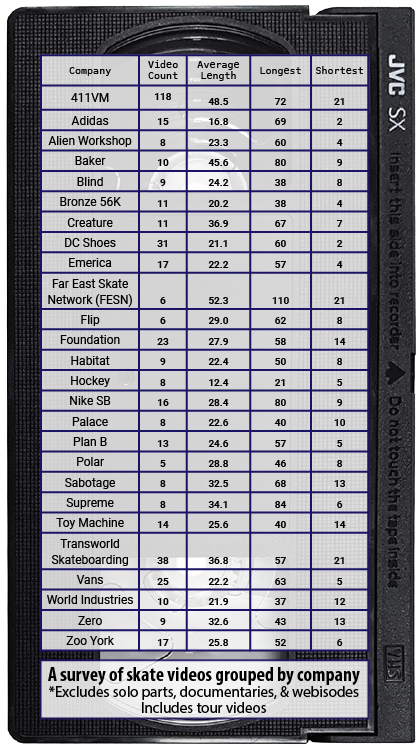
“The videos that had just came out also played a part,” says Lucas Wisenthal, former editor-in-chief of The Ride Channel. “People were tired of four-plus-year waits for overblown full-lengths like Pretty Sweet [78 minutes] and Parental Advisory [62 minutes], countdown clocks and everything. I think part of it is that the kind of skating we associated with full-lengths was getting old. ‘I film for the video in the streets and get clips at The Berrics, and I’m always wearing my sponsors’ gear.’ So we dismissed full-lengths.”
In his near-decade working for Deluxe, Fulton, a filmer who became a team manager, has made just a single full-length for the distributor, Krooked’s 2017 release, LSD: Let’s Skate Dude [30 minutes]. And while he says the biggest barrier to more full-lengths is teamriders’ disparate schedules, other factors are at play. Big-deal skating, he says, perhaps as part of a run for Thrasher’s Skater of the Year award, might be best released as a single part in order to not get lost in the mix of a longer edit. Sometimes, Fulton says, a handful of a team’s skaters will have enough footage for parts and want to package them together, like what happened with Real’s Three Seasons [16 minutes], released this January starring Gage Boyle, Patrick Praman and Tanner Van Vark.
“At the end of the day, we’re trying to make cool videos and package them whatever route we think is going to be the coolest,” Fulton says.
Crailtap, which pioneered so much short-form internet skate content, has released a string of full-lengths from its brands in recent years, despite the trend toward shorter videos. John Marello is the filmmaker behind two Girl videos, 2018’s Doll and 2020’s Nervous Circus [30 minutes and 17 minutes, respectively]; Chocolate’s 2021 release, Bunny Hop [43 minutes]; and this year’s Lakai release, Bubble [40 minutes].
“…suddenly you’ve been filming for three years and end up with the hour video.”
“I think we’re really lucky that everyone’s on the same page and they really want to be in these Crailtap projects. A lot of times, our riders will drop what they’re doing to be in these projects,” says Marello, pointing out that that’s made easier by skaters having multiple sponsors within the distro house, like Simon Bannerot riding for Girl and Lakai. There’s organizational support for long skate videos, too. He says brand founders Rick Howard and Mike Carroll are involved with the editing process and help shape videos so they come out in line with their vision. Marello himself says Girl’s 2003 video, Yeah Right! [72 minutes], “was the cornerstone for my skate video knowledge.”
“Ultimately, [full-lengths are the] best way to really show a brand, a team and the whole brand identity,” he says.
The identity of a local skate scene or crew can also come through more clearly in a a full-length video, says Fulton. “You’re watching it for a different reason, it captures a scene. You’re getting a vibe for the crew and those full-lengths capture that better,” he says. Ostrowski, who made 2017’s Genesis [27 minutes], 2020’s Genesis 2 [55 minutes] and this year’s Genesis 3 [60 minutes], says his videos have a tendency to get longer in an organic way. “We’ll set a deadline and we’ll have five or six people that have parts, then it’ll start growing, a new person gets into the mix late,” he says. “…suddenly you’ve been filming for three years and end up with the hour video.”
“If you can keep it under a 40-minute runtime, without credits and intro, I think that’s the sweet spot.”
Stewart says a similar process led to 2014’s Static IV and V [35 minutes and 38 minutes, respectively] – he cast a wide net for parts, thinking skaters would drop out, but then they never did so he had to make two videos. And whereas Ostrowksi says longer form videos are best for showcasing his crew and individual skaters’ personalities with full parts, intros, b-roll and all, Stewart says he sets out to create a feeling. The Static series, for example, is “spooky.”
“The short edits of the past 10 years don’t leave room for the videomaker, who doesn’t have a chance to inject a perspective, something beyond skating, a theme or a vibe,” Stewart says. “A meaningful piece of media should transport you and take your imagination outside the room where you’re watching your phone.”
The longest video in SkateVideoSite’s database is 900 Films’ 2001 opus, Tony Hawk’s Gigantic Skatepark Tour, which clocks in at 220 minutes. That’s three-and-a-half hours of skatepark footage. Another contender for longest video in the more traditional, non-tour and non-documentary category, is from Far East Skate Network, which released various titles out of Japan from 1995 to 2008. Its Overground Broadcasting video, released in ‘08, is made up of some 25 sections and clocks in at 110 minutes.
This year, when it was finally released in full, Tightbooth’s Lenz III challenged viewers with its 88-minute runtime. The filmmakers interviewed for this story weren’t sure if there is an ideal skateboard video runtime (one wonders if 411 Video Magazine, with its average video length of 48.5 minutes, over 118 releases, approached an ideal video length, at least for its era.) Marello offers the most complete formula: “If you can keep it under a 40-minute runtime, without credits and intro, I think that’s the sweet spot.” Fulton is more subjective: “As long as it’s captivating throughout the whole thing, the length doesn’t really matter,” he says, checking a recent release, Bubble, for praise. “That was awesome the whole way through, it felt like it went by so fast.”
“The biggest challenge is being memorable, not being seen – it used to be being seen.”
The form of skate videos has evolved over the past decade. Wisenthal points to the 2014 Supreme video, “cherry” [40 minutes], as a bridge between skate video eras — from the traditional structure of something like Pretty Sweet to something that plays like an extended edit, for instance, Polar’s 2018 release, We Blew It At Some Point [34 minutes].
In that vein, Marello advocates for never cutting to black as a means of keeping viewers engaged, while admitting that skaters’ consumption patterns have changed. “People definitely have shorter attention spans than before. It’s less of a commitment to watch a video than it was before.”
That’s because it’s never been easier to watch a skate video, a fact that Stewart says inverts the previous goals of skateboard filmmakers. “The biggest challenge is being memorable, not being seen – it used to be being seen.”
Ostrowski, having put out consecutive full-lengths, each around an hour long, has a YouTube page packed with shorter edits. He’s also been making a series of quicker-hitting montages for Jenkem Mag called “G-FILES.” He says there are plenty of reasons to make shorter videos, some already mentioned, others including the lack of pay involved in making substantial independent videos, but he’s still torn. “I just really love the longevity of [full-lengths] and the feeling of going to a premiere. We’re hitting a point where we almost want to start making shorter videos and montage things, but I feel like not all the guys see the benefits of the longer form video. The most important thing to me is being able to leave a mark and give everyone a voice, skate-wise, having their name in the video, little things like that.”
Despite steadily falling average video lengths, the demise of the full-length skateboard video continues to be greatly exaggerated. This past August was a bumper month for videos, and the worldwide tour which Stewart has been on to premiere Static VI seems to indicate there’s still plenty of appetite for longer, complete videos that transport viewers.
Full-length skate videos also offer more to their makers, Stewart says, perhaps explaining why he’s pursued the Static series for more than two decades. “It’d be like if you’re a painter, but for the past 10 years, you’ve been doing everything on your tablet. At a certain point, I want to experience more of the artistic side of it – I don’t just want to be creating an image, I want to go through the process of creating an actual tangible piece of art,” Stewart says. “There’s something so rewarding about the process of making full-length videos that they refuse to die.”







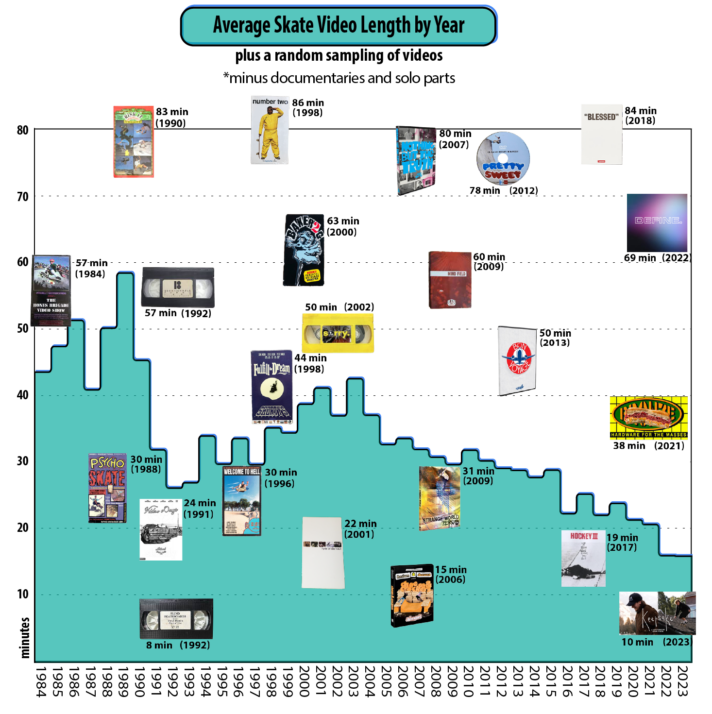
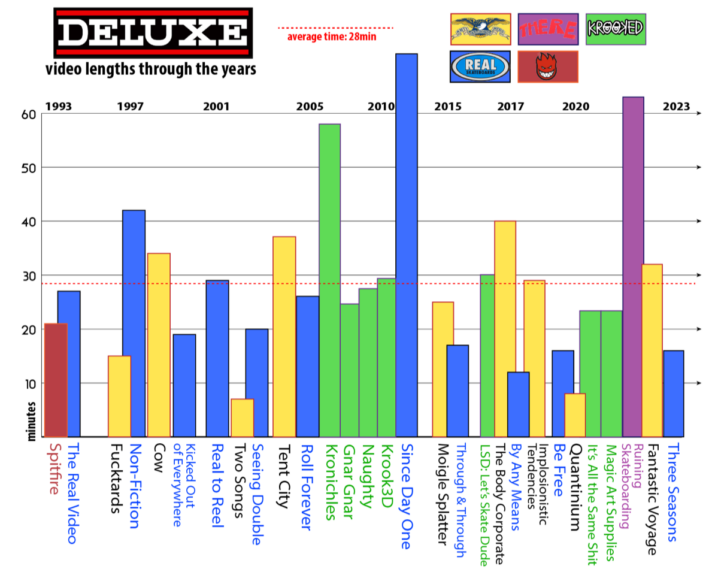
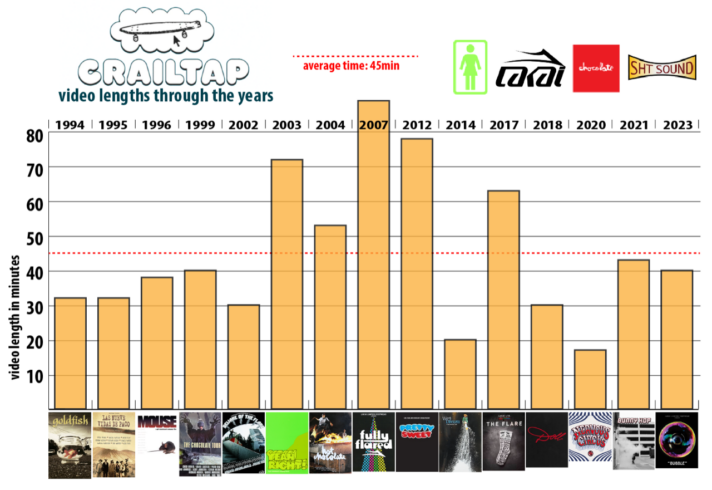
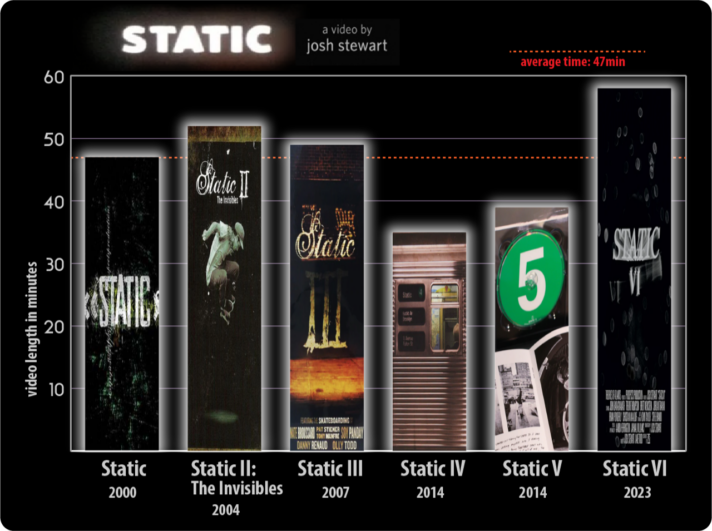
This is amazing.
Content Kings
This article got me hyped to skate
this helps
How nice how are the sales youre qndrew urias! Remember youre baby moma lannette lopez u left her in the dust but how they say some one else junk some ones Treasure